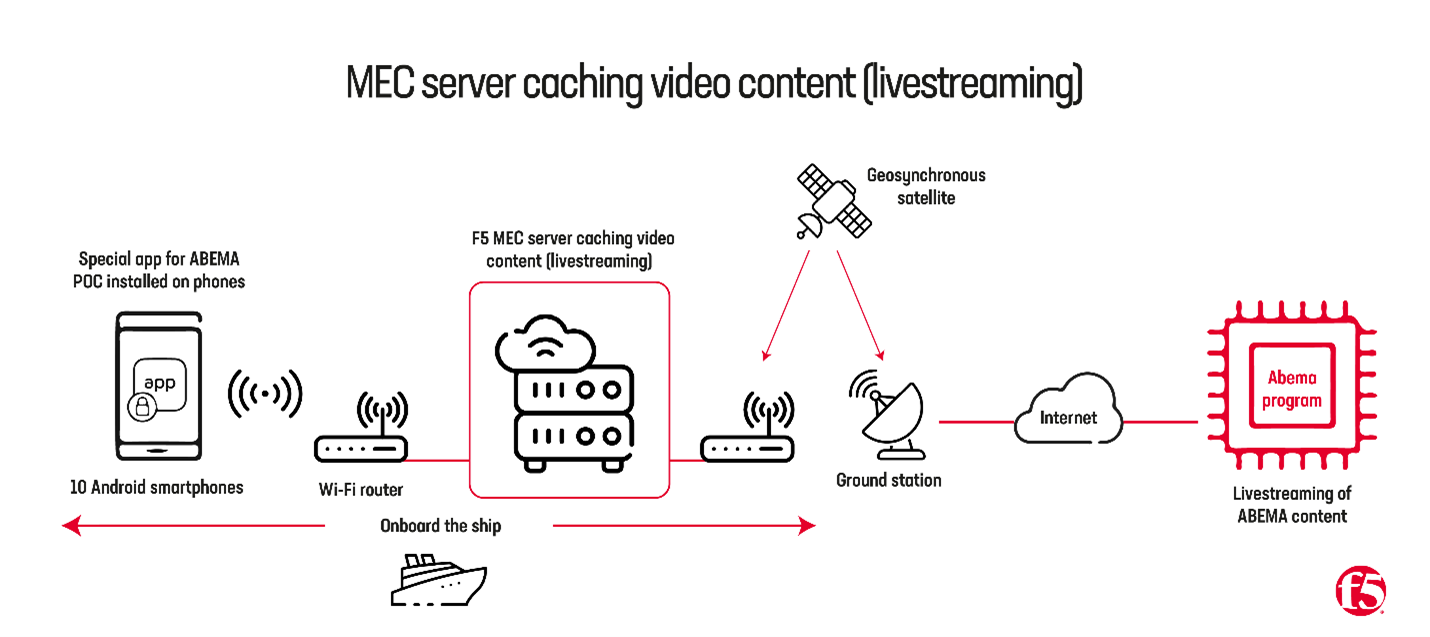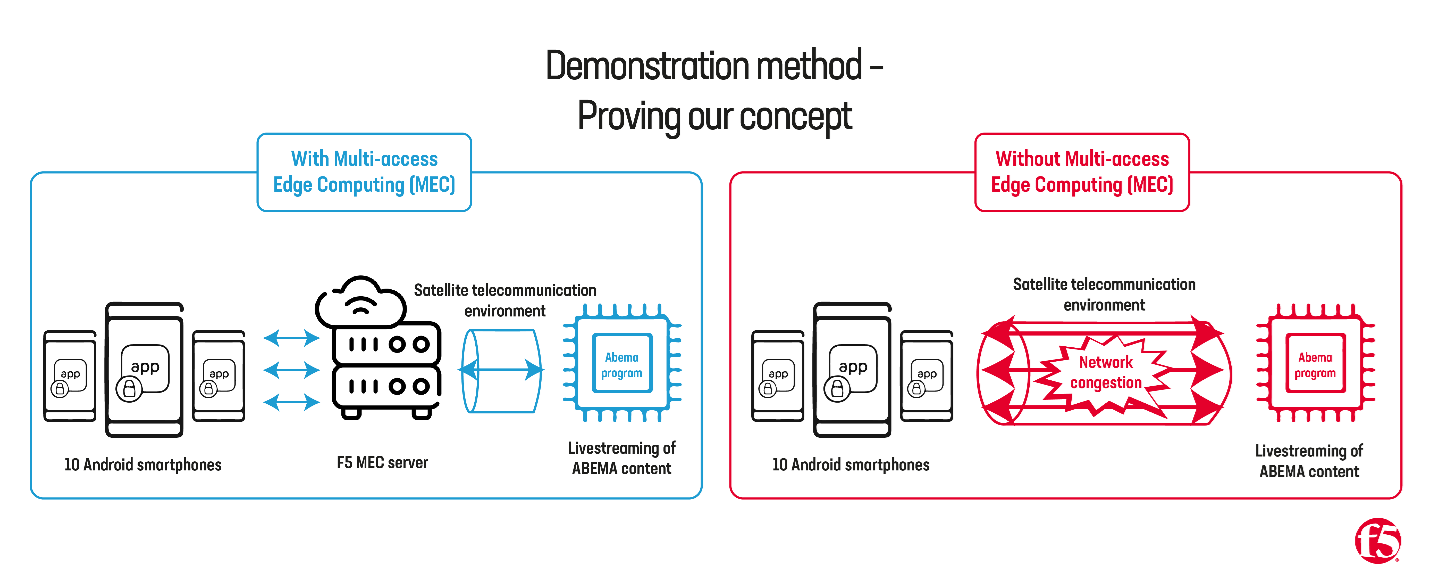SoftBank Corp.와 F5, 멀티 액세스 엣지 컴퓨팅으로 라이브 비디오 방송을 테스트하기 위해 바다로 향하다
디지털 혁신은 업무 개념 자체부터 디지털 경험에 대한 소비자 기대까지, 우리가 익숙한 규범에 계속해서 도전하고 있습니다. 조직에서는 지연 시간을 낮추는 동시에 지속적으로 높은 디지털 성능을 제공할 수 있는 잘 개발된 네트워크 기능을 유지해야 합니다.
통신 서비스 제공업체가 5G로 차세대 네트워크 기능을 적극적으로 정의하고 구축하는 동안 특정 영역은 불가피하게 "notspots"로 남을 것입니다. 이러한 지역에서는 네트워크 커버리지가 전혀 없거나 미미하기 때문에 기업이 해당 지역에서 우수한 디지털 경험을 제공하는 데 장애가 됩니다. 또한, 특히 비디오 수요 증가에 따라 엣지 컴퓨팅 솔루션에 대한 수요가 증가함에 따라 네트워크 과부하를 방지하는 동시에 이러한 경험을 제공해야 하는 압박이 커지고 있습니다.
엣지 컴퓨팅이 이러한 측면에서 달성할 수 있는 가능성의 한계와 경계를 넓히기 위해, 우리는 SoftBank Corp.와 협력하여 흥미로운 개념 증명(POC) 프로젝트를 테스트했습니다.
저희의 목표는 간단했습니다. F5 캐싱 기술을 사용하여 대역폭이 제한된 통신 환경에서 MEC를 구현하고 콘텐츠를 브로드캐스트하여 위성 통신 환경에서 멀티 액세스 에지 컴퓨팅(MEC)의 실행 가능성을 입증하는 것이었습니다.
저대역폭 환경의 한계 테스트
우리는 이러한 컨셉을 실현하기 위해 TV 및 비디오 엔터테인먼트 서비스인 ABEMA와 협력하여 야심 찬 방송 이벤트를 진행했습니다. 우리는 MEC를 통해 동시에 연결되는 단말기의 수를 늘렸음에도 불구하고 지연 시간을 최소 수준으로 유지할 수 있는지 테스트하고 싶었습니다.
우리의 역량의 한계를 실제로 시험해 보기 위해, 우리는 바다 멀리 떨어진 배에 테스트베드를 설치했습니다. 이곳은 대역폭이 극도로 제한적인 환경이어서 ABEMA에서 실시간 비디오를 방송할 수 있었습니다.
우리가 이룬 성과는 유망했습니다. 이전에는 원격 지역 등 통신 서비스에 접근할 수 없는 저대역폭 환경의 문제로 인해 불가능했던 비디오 방송 기능에 획기적인 변화가 생긴 것입니다.
우리의 실험에서는 10개 이상의 장치와 단말기에 동시에 연결되어 안정적인 브로드캐스트가 관찰되었고, MEC 뒤의 네트워크에 걸리는 부하는 거의 동일하게 유지되었습니다. 동시에 연결된 단말기의 수가 늘어났음에도 불구하고 지연 시간은 최소로 유지되었습니다. 맥락을 파악하기 위해, 우리는 동시에 1~2대의 스마트폰에서만 콘텐츠를 볼 수 있는 기내 위성 통신 환경을 만들었습니다.
멀티 액세스 엣지 컴퓨팅 기능에 대한 더욱 많은 개선 사항
바다에서 안정적으로 비디오를 스트리밍할 수 있다는 전망이 유망한 반면, 저는 애플리케이션 콘텐츠를 빠르고 안정적이며 안전하게 전송할 수 있는 가능성에 더욱 기대가 큽니다.
우리는 대역폭이 제한된 위성 통신 환경에서도 애플리케이션 전송이 가능하다는 것을 입증했을 뿐만 아니라, 애플리케이션 전송을 더 빠르고, 스마트하고, 안전하게 만들었습니다.
이 개념의 실현 가능성이 입증됨에 따라 보다 원활한 사용자 상호작용을 가능하게 하는 사용 사례 목록이 확대될 가능성이 있습니다. 이러한 솔루션은 조직이 안전하고 최적화되고 차별화된 경험을 통해 전 세계적으로 분산된 애플리케이션을 제공해야 하는 오늘날의 고도로 디지털화된 세상에서 매우 중요해질 것입니다. 가능성은 무한합니다. 스마트 시티 구축부터 스마트 전기 자동차 에너지 관리, 몰입형 비디오 스트리밍 등 다양한 분야로 확장 가능합니다.
엣지 컴퓨팅의 다음 단계로 이동
이제 컴퓨팅은 네트워크 가장자리에서 이루어집니다. 애플리케이션 보안과 전송 기능을 에지까지 확장함으로써 컴퓨팅 및 스토리지 기능을 네트워크 핵심에서 멀리 떨어뜨리고 최종 사용자와 그 장치에 더 가깝게 옮겨 더 나은 애플리케이션 성능과 전송을 실현할 수 있습니다.
새로운 기술 설계 원칙을 기반으로 하고 전체적인 애플리케이션 배포를 중심으로 구축된 Edge 2.0은 동적 환경에서 애플리케이션의 진정한 이동성을 구현합니다. 당사 최고기술책임자인 갱린은 Edge 2.0을 미래 분산 애플리케이션이 직면할 과제를 해결하는 새로운 패러다임으로 봅니다 . F5에서는 이 기술 이 적응형 애플리케이션 에 대한 당사의 비전을 어떻게 발전시키고 궁극적으로 고객에게 뛰어난 디지털 경험을 제공할 수 있을지 기대하고 있습니다.
저희는 F5 포트폴리오를 강화해 나가면서 다양한 산업 분야의 고객에게 동급 최고의 맞춤형 솔루션을 제공할 준비가 되어 있습니다. 또한, SoftBank Corp.와의 이번 개념 증명이 성공함에 따라 MEC 기술의 범위를 확장하는 솔루션을 개발하기 위한 협력을 계속해 나갈 수 있기를 기대합니다.


